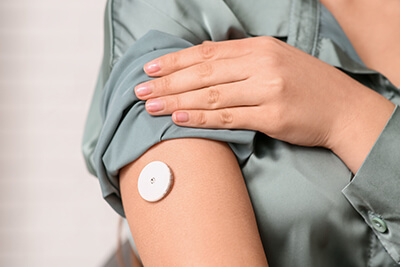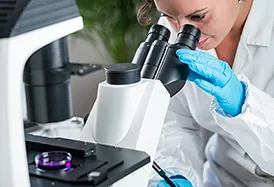 A medical device startup sought engineering services for a wearable sensor to monitor vital health parameters for nephrology clinicians. The device would allow patients to be remotely monitored for chronic kidney disease and end-stage kidney disease. Based on the requirements, our healthcare product development expertise aligned ideally with this groundbreaking innovation.
A medical device startup sought engineering services for a wearable sensor to monitor vital health parameters for nephrology clinicians. The device would allow patients to be remotely monitored for chronic kidney disease and end-stage kidney disease. Based on the requirements, our healthcare product development expertise aligned ideally with this groundbreaking innovation.
Our client required the wearable device to measure basic vitals and hematologic parameters including potassium indications — without needle sticks. To bring the noninvasive remote patient monitoring product to market, they needed engineering services to develop an IoMT product to collect and share patient data as well as develop software and a dashboard for clinicians and clinical trials.
The Challenge of Designing a Wearable Patient Monitoring System
The wearable sensor collects data used to process multiple health parameters, including heart rate, skin temperature, hematocrit, hemoglobin, potassium indications and auscultation. The data is transmitted from the wearable device to a hub and, from there, to the cloud for processing the data in real-time. The solution has 510k and meets the IEC 13485 requirements for medical devices.
During the product development, the engineering team overcame these key technical and logistical challenges.
- Rearchitecting the design to support reliable data collection and transmission for clinical trials and real-world applications.
- Connecting the wearable sensor device to the telemetry hub and software needed to transmit patient data to the cloud.
- Supporting a start-up in advancing their device upgrade including processes and documentation to prepare for FDA submission.
Our client created the first fully operational nephrology patient monitoring system that allows clinicians to remotely monitor data and alert the patient care team regarding changes in health parameters.
Remote Patient Monitoring Software Expertise Brings the System Together
For more than four years, Cardinal Peak delivered comprehensive engineering solutions across multiple aspects of the wearable patient monitoring system.
Cloud Infrastructure and Back-End Design
Our engineers architected a reliable cloud services infrastructure and back-end design that could manage data collection, storage and transmission from the wearable sensor to the hub and then to the cloud. Without this foundation, supporting clinical trials and eventual patient care applications would have been challenging.
Software for the Clinical Dashboard
The Cardinal Peak team developed iOS software for the clinical environment, helping healthcare providers:
- Monitor patient data in real time or offline.
- Set up customizable alerts for critical health parameters.
- Access patient health data remotely.
- Prompt intervention to improve patient outcomes.
Most notably, the clinical interface allows clinicians to monitor data and to alert the care team regarding changes in health parameters and make recommendations regarding care.
System Integration
Our engineering team successfully collaborated with the client to integrate components into a cohesive patient monitoring platform that connects the wearable sensor to the hub and seamlessly transmits data to cloud-based services for clinical access.
Remote Hub Innovation
To bridge the gap between the wearable sensor and the cloud in remote applications, Cardinal Peak developed a specialized telemetry hub. It remotely collects sensor data when the device is disconnected from the cloud and transmits data when the hub is reconnected. This makes the system suitable for various deployment scenarios, including data collection in remote environments.
Verification Testing and Regulatory Compliance
Finally, our quality assurance team conducted extensive engineering confidence and verification testing to ensure functionality and IEC 62304 compliance. Cardinal Peak developed test platforms to verify the functionality of the wearable sensor connectivity to the telemetry hub data collection and data transfer to the cloud.
Helping Boost Kidney Patient Care Outcomes
With Cardinal Peak’s support and expertise, our client achieved its goal of creating the first fully operational nephrology patient monitoring system.
Clinical trial success
Cardinal Peak’s infrastructure and software development work accelerated the product’s path to clinical trials and, eventually, to market.
Improved patient outcomes
The system enables real-time remote health monitoring, allowing clinicians to detect and address health issues before they become critical, proactively improving overall kidney care.
Better care efficiency
Care providers can now remotely monitor multiple nephrology patients simultaneously, reducing the need for frequent in-person visits while maintaining a high standard of care.
Reduced healthcare costs
Early warning capabilities and interventions minimize hospital visits and costly medication or treatments, saving both patients and healthcare providers time and money.
Lower patient anxiety
Despite often being quite sick, patients with severe kidney conditions enjoy greater peace of mind via continuous monitoring. Knowing their care team can remotely monitor their condition and respond quickly to any concerns helps reduce anxiety and improve quality of life.
The successful deployment of this patient monitoring system underscores Cardinal Peak’s IoMT (Internet of Medical Things) development aptitude. We combine engineering expertise across technologies and industries with a commitment to patient-centric design.
Cardinal Peak is Your Partner for Medical Device Development and Innovation
As remote patient monitoring increases in consequence in the era of digital healthcare, Cardinal Peak stands ready to help medical device companies transform their innovative concepts into market-ready solutions.
The time for better patient care is now — and driven by new technologies. Whether you’re developing a smart medical device or a comprehensive remote monitoring system, let’s discuss how we can transform healthcare for the better together.



